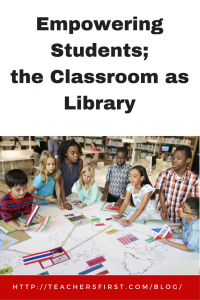 While the month of April brings thoughts of spring showers and May flowers, for this school librarian, April reminds me of National Library Week and its companion, School Library Month. I love the fact that there is a special time of the year dedicated to libraries.
While the month of April brings thoughts of spring showers and May flowers, for this school librarian, April reminds me of National Library Week and its companion, School Library Month. I love the fact that there is a special time of the year dedicated to libraries.
You don’t have to convince Americans that their libraries are important. Over the last five years, the Pew Research Center has found – time after time – that Americans support their local libraries, even if they do not use them. In a survey taken in 2015, two-thirds of Americans ages 16 and older said that closing their local public library would have a major impact on their community. Another survey in 2016, found that close to 50% of people reported visiting a library yearly and about 25% used the library website. Many businesses would envy such statistics.
Use of print resources, while still strong, has declined slightly, but people report using libraries to access technology and the Internet, while the use of the online library services is increasing via mobile devices. Overall, Pew concludes that people regard libraries as educational institutions, not just supplements to leisure, and those who use libraries consider themselves lifelong learners.
So what makes an inviting library that has positive vibes for all? And how can we take lessons from libraries into the classroom? We might say every visit to any library, public or school, is a genius hour. TeachThought says “Genius Hour in the classroom is an approach to learning built around student curiosity, self-directed learning, and passion-based work.” Edutopia in a post about personalized learning, has some tips for getting started with a genius hour. We may visit the library for a specific purpose, but it is easy to jump-start our own learning and wander the library, or the web, as what we read piques our interests. Free choice is a powerful positive for libraries and classrooms. Just think about how much more eagerly students will select a book to read when it is their choice.
Of course, free choice requires choices, so we need to provide a wide variety of materials for all interests. In the classroom, this translates to teaching to the student and letting the classroom be student-centered, individualized and/or differentiated. The website Understood has a brief, helpful post on understanding the difference between individualized and differentiated instruction. Differentiated instruction starts with groups of students; individualized instruction is designed for one student. Check out additional ideas for providing differentiation at the TeachersFirst page “Differentiating Instruction: Ideas for Individual Differences.”
Students from middle grades up love classroom activities that involve collaboration. Contrary to the stereotype of the quiet, sterile spaces, libraries offer many choices for students to work together, with or without connected devices. Libraries have the access points and the assistance to help make collaboration meaningful. But they still provide that out-of-the-way corner for an individual learner to work or maybe just stare off into space. For our classrooms, this points back to differentiating instruction.
The makerspace movement in libraries aims to nurture both creativity and collaboration. We will look at makerspaces in depth in a later post, but Diana Rendina’s site Renovated Learning is a great place to find out more about makerspaces, and how to create and run one. She shares research about makerspaces and offers this definition: a school library makerspace is “a place where students can gather to create, invent, tinker, explore and discover using a variety of tools and materials.”
Makerspaces can be elaborate, incorporating power tools and sewing machines, or as simple as a few tables with art materials, such as poster board, paint, crayons, or maybe computers with photo editing or movie-making software. Think how enthusiastic students can become when extending classroom learning into authentic projects, creating their own products to be shared with the school community and beyond the school walls.
I appreciated one of my principals who, after spending a period observing me working with a class and teaching research skills, left saying, “Thank you for letting me visit your classroom.” He “got it” that the school library is the biggest, best classroom in the building, one designed for all students. The American Association of School Librarians’ theme for the 2017 School Library Month is “Because School Libraries Empower Students.” Isn’t that what our school libraries and classroom are about? It’s empowering students to become lifelong learners.


Empowering Students; the Classroom as Library:
I learned that no matter what grade we teach, free choice requires choices, so we need to provide a wide variety of materials for all interests. In the classroom, this translates to teaching to the student and letting the classroom be student-centered, individualized and/or differentiated. My classroom has a large leveled library. Then we created a small section of the classroom, with non fiction, author baskets and read alouds that they can read, look through and share with a partner. The website Understood has a brief, helpful post on understanding the difference between individualized and differentiated instruction. Differentiated instruction starts with groups of student while individualized instruction is designed for one student.I found this helpful with additional ideas for providing differentiation at the Teachers First page “Differentiating Instruction: Ideas for Individual Differences.”